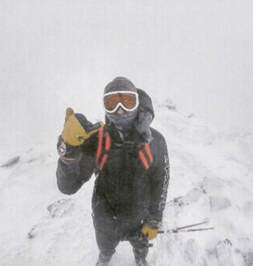|
By Coach Nick Happy Wednesday Everyone! I hope you are all enjoying the beautiful weather and cooler temperatures this week! As the weather begins to shift this time of year we are going to shift our topic of discussion from hot weather to cold weather. Today’s Wilderness Medicine Wednesday post is going to be about hypothermia. As most of you probably know, hypothermia is when the body’s core temperature drops to dangerous levels. Hypothermia is an injury that occurs progressively and has many definitive stages, these stages can range from inconvenient to the patient to fatal. If you spend a lot of time in wilderness settings it is important to understand the risk factors and causes of hypothermia as well as the signs, symptoms, and treatments associated with it. First thing’s first: It does NOT have to be cold, raining, or snowing for someone to get hypothermia. The risk of someone getting hypothermia is ever-present and should never be thrown away, even in the summer. Especially this time of year it is conceivable to hike in the Bridgers (or anywhere) with a starting temperature of 85 degrees and encounter 40 degree temps or lower on the summit. This drop combined with wind chill and moisture from sweat puts us at great risk for hypothermia. No matter what you are doing or what the temperature is outside you should always pack appropriate warming layers that will keep you warm in the worst case scenario you may encounter. For example, if you choose to hike Baldy and it’s 85 degrees at the “M”, you should probably pack the right layers to keep yourself warm at about 40-45 degrees which you may encounter on the Ridge. If you want to do some winter hiking and its 30 degrees at the “M” you should probably pack for 10-15 below, etc. Having the right gear is important, of equal importance is keeping that gear, and yourself, dry. Water is the #1 enemy when it comes to hypothermia so I’ll share a few tips. Always keep your warming layers that you’re not wearing in a dry bag, if you fall into water or it starts raining these need to stay dry. Do you best to sweat as little as possible. Start your hike with the least number of layers on as possible, you should be comfortably cold. As you hike and start to warm up, shed even more layers to avoid sweating. You’ll thank me for this when you get to the summit and the sweat on your body doesn’t make you freezing cold and you have dry layers to put on (side note, in winter hiking it’s possible to get heat injuries due to too much layering). If you haven’t already done so it’s time to ditch any cotton layers you own and invest in merino wool, or synthetic materials. These can potentially save your life as cotton is notoriously slow drying while the others can dry in minutes. Now that we have briefly discussed risk factors and prevention of hypothermia let’s talk about what happens when you or one of your partners in the wilderness becomes hypothermic. As I mentioned, hypothermia occurs when your CORE body temperature drops. The temperature that our body is supposed to operate at is 98.6 (ish) degrees. We are considered hypothermic when our core temp is 97 degrees, yes that’s right, just one degree different. At this temperature our body realizes that something is wrong and enters life-saving mode. The first thing that happens is our body tries to conserve energy and slows brain function. We also begin a process called vasoconstriction, this is when the body restricts blood flow to the skin to create another layer of insulation. Our metabolism will increase, burning more calories produces more heat, just like a fire. These bodily responses will manifest themselves in a few ways: the person will appear “out of it” as their brain function is slowing, their skin (especially their lips) will appear bule or purple, and they may start to appear angry or apathetic. This stage is just the beginning of hypothermia and is not particularly dangerous, we can still operate at this level. However, things begin to go South from here quickly. I won’t spend too much time on the next stages but I’ll just go over the important signs. From 96-90 degrees a dangerous progression will occur as the body gets closer to death. Shivering is the body’s next response to being cold, this is your body’s attempt to warm itself by creating friction within opposing muscle groups. The problem is that shivering burns a lot of energy, which is bad considering our metabolism is already spiked. Next, the body will pull the blood from our extremities to our main organs in an attempt to keep them alive longer. Combined with vasoconstriction this causes us to lose our fine motor skills including speech. While all of this is going on the brain is beginning to shut down and conserve energy. You will see a visible decline in cognition as this is going on. Patients will lose the ability to do simple math and their judgement will be compromised. A lot of patients in these stages won’t even feel cold and will want to continue doing whatever they were doing, obviously don’t let them. Finally, in the last stages of hypothermia the patient will adopt the fetal position and their level of consciousness will be almost unresponsive. At 86 degrees the brain will basically shut off and the patient will appear dead, you won’t even be able to feel a pulse. This part is important: DO NOT PERFORM CPR. Even though the patient appears dead they are not (for a few hours at least). At this stage the heart is beating so slow that it won’t even be detectable on a monitor but it is still going, performing CPR or shocking them with an AED would almost certainly kill them. Patients at this stage are saved by slow warming in a controlled environment and will not be pronounced dead until warmed to a normal temperature. There’s a common rule in medicine that if the brain goes without oxygen for more than 6 minutes it will cause permanent damage/death. This is true in every case except hypothermia, because the body is so cold you can actually survive for a surprising amount of time in this severely hypothermic state. Now that the doom and gloom is over let’s talk quickly about treatment. Luckily hypothermia is pretty easy to treat especially if it’s recognized early. Remember, water is public enemy #1 (on the outside of the body, make sure to keep the patient hydrated). The first thing we need to do is remove any wet clothing the patient has on and get them dry. Next, we need to warm them up however possible. This is best done by creating what we call a hypo-wrap. Think of a hypo wrap as a big burrito of clothes with the patient in the middle. First, lay down something large like a tarp followed by a sleeping pad to keep them off the ground. Then wrap the patient with a space blanket first (if you have one) followed by everything else you have that’s warm. After you get them in the hypo-wrap they need two things: sugar and water. Dissolve any sources of sugar you have into warm water and feed them that way, hypothermia patients can not digest solid food. For severely hypothermic patients we need to take extra precautions not to move them violently (this can stop their heart), and provide rescue breaths to get oxygen to their brain if they stop breathing. Hypothermia is a serious condition but it is easily reversable and recognizable. If you or a member of your party is becoming hypothermic it is crucial to stop whatever you are doing and go home, pushing past these early stages is how people end up on the severe end of this spectrum! I know this was a long post but this is a somewhat complicated topic with many considerations. I will be writing in more detail about this as the winter approaches as well! I hope this post was useful to you guys and maybe taught you a thing or two. I have a pretty extensive background in cold weather environments and would be happy to answer any questions you guys have! Have a great rest of the week and keep crushin’ it in the gym! Thanks for reading!
0 Comments
Leave a Reply. |
Special EventsRecord your WOD on Beyond the Whiteboard.
Do you need CrossFit or yoga gear? Click on the links below to buy through our GORUCK, Reebok, Rogue or Affiliate share sale programs. These are affiliate links and our gym will be compensated if you make a purchase after clicking on these links.
Check out our Flickr page!
Categories
All
Archives
April 2024
|
True Spirit CrossFit
|




 RSS Feed
RSS Feed

